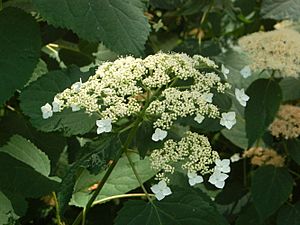Hydrangea radiata facts for kids
Quick facts for kids Silverleaf hydrangea |
|
|---|---|
 |
|
| Inflorescence of Hydrangea radiata at the park of Villa Serra, Genova, Italy | |
| Scientific classification | |
| Genus: |
Hydrangea
|
| Species: |
radiata
|
| Synonyms | |
|
Hydrangea arborescens L. ssp. radiata (Walter) E.M. McClintock |
|
The Silverleaf Hydrangea (scientific name: Hydrangea radiata) is a beautiful shrub that can grow up to 3 meters (about 10 feet) tall. It belongs to the flowering plant family called Hydrangeaceae. You can find it naturally in the southern Appalachian Mountains in the United States. It's also known as the Snowy Hydrangea. These names come from its special leaves, which are dark green on top but a shiny, silvery-white underneath. This makes the plant really stand out, especially when the wind blows!
Where It Lives
The Silverleaf Hydrangea is native to (meaning it naturally grows in) the mountainous areas of the southern Blue Ridge Mountains. These areas are usually higher than 2,000 feet (about 610 meters) above sea level. You can find it in parts of Tennessee, North Carolina, northwestern South Carolina, and northeastern Georgia.
This plant often grows near streams, on rocky hillsides, and along roads. It's especially common near the Chattooga River and in the French Broad River Valley. You might easily spot it along roadsides where North Carolina, South Carolina, and Georgia meet, especially near towns like Highlands, Cashiers, and Rosman, North Carolina. Sometimes, you might even see it in the Piedmont Region, but these plants might have spread from gardens.
Plant Family and Relatives
The Silverleaf Hydrangea is quite similar to two other types of native hydrangeas: the smooth hydrangea (Hydrangea arborescens) and the ashy hydrangea (Hydrangea cinerea).
For a while, scientists thought that both the silverleaf and ashy hydrangeas were just different types (subspecies) of the smooth hydrangea. However, most plant scientists now agree that they are all separate species. This means they are distinct kinds of plants.
How did they figure this out? A scientist named Ronald Pilatowski did experiments where he tried to cross-pollinate these plants. He found that even though they look similar and grow in the same areas, they produced very few healthy seeds when crossed. This showed that the plants keep their own unique genetic makeup and special features, proving they are different species.
What It Looks Like
The flowers of the Silverleaf Hydrangea grow in a flat-topped cluster called a corymb. These clusters have many showy, white flowers around the edges. These special flowers don't produce seeds but are there to attract pollinators. There are usually 2 to 15 of these showy flowers in each cluster, and they are typically larger than 1 centimeter (about 0.4 inches) across.
The leaves of the Silverleaf Hydrangea are quite large, usually 8 to 15 centimeters (about 3 to 6 inches) long. They grow in pairs directly across from each other on the stem. The edges of the leaves are serrated (like a saw), and their shape is oval. Since it's a deciduous plant, its leaves fall off in the autumn.
The top surface of the leaves has small hairs along the veins. But the most interesting part is the underside of the leaf! It's covered with a thick, felt-like layer of hairs, which makes it look bright white or silver. If you look closely with a magnifying glass, you'll see these hairs are smooth. They are so thick that you can't even see the leaf's skin (epidermis) underneath!
Uses and Growing Tips
This beautiful shrub has a lot of potential for landscaping in gardens. It looks great and can add a unique touch with its silvery leaves and white flowers.
However, the Silverleaf Hydrangea needs specific conditions to grow well. It prefers cool, moist places with some shade. It's not as good at handling heat and dry weather as the smooth hydrangea. It can also be a bit harder to grow new plants from cuttings compared to the smooth or ashy hydrangeas.
One great thing about the Silverleaf Hydrangea is that it produces more showy flowers than its relatives, the smooth and ashy hydrangeas. It can grow in hardiness zones 4 to 9. If you live in a warmer area (like zone 6 or higher), it's best to plant it in a spot that is protected from too much sun and heat. Some popular types (cultivars) of this plant are named 'Samantha' and 'Terri Greer'.


